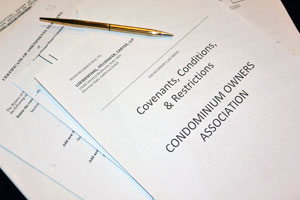When an owner purchases a property as an investment, the legal obligations of renting may be far from the owners mind. Some owners, not wanting the responsibility, hire a licensed real estate broker to find a qualified tenant and manage the tenancy for a fee. Owners handling the rental themselves should be familiar with the state and municipality’s laws regarding discrimination, deposits, and eviction.
Additionally for their own protection, owners should acquire proper forms to be completed and signed by tenant and owner including rental application form, security deposit form, and lease. Without these properly completed and signed forms an owner can end up with a long-term nonpaying or otherwise undesirable tenant.
Additionally, an owner who buys a unit as a rental in a common interest development has the additional responsibility of complying with the association’s documents relating to renting. In some common interest developments leasing of units is prohibited by the CC&R’s. The seminal case on this issue is City of Oceanside v. McKenna (1989) wherein the court held that a lease restriction in the CC&R’s is enforceable in a condominium project subsidized by a local redevelopment agency to provide low cost housing to local residents. If enforced in a uniform manner, it did not constitute an unreasonable restraint on alienation under Civil Code §711 as the restriction was intended to foster the redevelopment goals of providing a stabilized community of owner – occupied units for low and moderate income persons.
If the governing documents prohibit renting of units, the municipality in which the property is located can grant exemptions to these requirements under certain circumstances and the municipality ruling would supercede the association’s documents. Communities subsidized by redevelopment funds should include rules prohibiting owners who do not get exemptions from the municipality to lease their units. The policy should include a violation process with fines and further legal action in order to enforce the portions of the documents pertaining to leasing of units. In the absence of the circumstances cited, herein, associations can not legally restrict owners from leasing their units. However the association can and should establish policies and procedures regarding rented units. In common interest developments, unit owners are legally responsible to the homeowners association as they are the members of the association and the legal relationship is through the owner. Owners sometimes want to use the association, through the manager and/ or management company, as their rental agent or apartment manager and not take responsibility for their tenant. Tenants are given the message from the owner that if you have any problems contact the homeowner association.
CC&R’s address the responsibility of tenants to owners in a section giving responsibility for any damages or violation of the CC&R’s to the owner when these violations or damages are caused by owners guests, pets or tenants. Owners are responsible for ensuring that their guests, pets and tenants do not create a nuisance or unreasonably interfere with the rights of others. It is recommended that boards of directors establish a policy for owners who lease their property and that the policy be a part of the Rules and Regulations of the association. An association may also modify their CC&R’s to include language regarding the leasing of units including language that is required to be included in leases between tenants and owners.
An association’s policy regarding tenants should include the following items:
• Owner is required to provide a copy of legal documents to tenant including CC&R’s and Rules and Regulations.
• Owner is required to provide a copy of a lease signed by both owner and tenant to association.
• The lease is to include language that the tenant has been provided a copy of the CC&R’s and Rules and Regulations and agrees to abide by them.
• Lease to be signed by all who will reside in the unit and to state if pets are to be allowed or not.
• Owner is required to provide a copy of a document signed by the tenants stating that the tenants have received a copy of the CC&R’s and Rules and Regulations. Failure to provide the information would result in fines being assessed against the owner.
• If tenants violate a rule and the association sends a notice of violation, the notice goes to the owner as the entity with the legal responsibility to the association.
• A copy of the violation is to be sent to the tenant.
• A policy for rule violation hearings should include terms as to whether or not a tenant can attend the hearing before the board of directors, if the owner must be present, and if the tenant must have written permission from the owner to appear before the board at a hearing.
• Associations may charge move in fees for new residents moving into the community. The fees should be reasonable and represent charges for costs such as providing keys , entering resident information into a gate system if applicable and processing the necessary paper work. The move in fee would be the same for owners moving in as for tenants.
Owners may want to include language in their contractual agreement with their tenant (lease) requiring tenant to pay for any fines assessed by the association for rule violations. Such an agreement is between the owner and the tenant and the association is not responsible for collecting monetary fines from the tenant. The association has no authority to assess fines to tenants; therefore; owners would be assessed fines as the legally responsible member of the association.
It is good policy for an association not the divide the community into owners and tenants . Therefore, boards of directors should communicate with tenants as they do with owners, i.e. newsletters sent to owners should be sent to tenants as well. Changes in Rules and Regulations should be sent to tenants, etc.
Tangential to the issue of rental restrictions is the issue of the right to use common areas by an owner when he rents his unit. When owners lease their property they give up their right to use common area facilities to the tenant as determined in the case of Liebler v. Point Loma Tennis Club (1995) – In this case, the owner of a unit wanted to retain his right to use the tennis facilities at his association while leasing his unit. The appellate court upheld the lower court decision that nonresident owners whose units are rented do not have the use of the recreational facilities. Another case, MaJor v. Miraverde Homeowners Assn. (1992) may be in conflict with the Liebler case as the decision in this case stated that a rule prohibiting a non-resident owner from using the common area recreation facilities when the unit is occupied by another family member is unenforceable. The family member in this case was an 82 year old woman who did not utilize the recreational facilities so there was no double usage of facilities. The case did not rule on whether an owner who leases a unit and delegates rights of use to the common area may be prohibited from using the facilities but indicated that a different rule might apply to such a case. Therefore the circumstances are different in this case than in the Liebler case.
Associations with high percentages of renters may face special problems and difficulties. As an example certain insurance carriers will not provide insurance to associations with high tenant populations or the insurance premiums for these associations may be substantially higher than for associations with lower percentages of tenants. In addition, certain lenders will not approve loans or refinance units in associations with high percentages of tenants.
Rental units in community associations are a fact of life. Associations that have policies in effect that address the rental units in their community and those that do not divide the community into owners and renters but treat all residents equally will have fewer problems with the renter population in their community.
SPECIAL ADMINISTRATIVE AND MAINTENANCE ASSESSMENT
Legislation regarding special administrative and maintenance assessments for owners who lease their units is being considered. Currently, no laws exist that provide for costs incurred by associations and management companies for the administration and management of units occupied by nonowner residents (tenants). These costs can include additional insurance premiums, additional maintenance costs, and administrative fees. If a tenant sustains injury inside of the unit, the tenant will generally seek recovery for injury and/or damages directly from the landlord, i.e. unit owner. If a tenant sustains injury while outside of the unit on common property, the tenant will most likely seek recovery of damages directly from the association. Though the owner may also be named and included in the action, the thrust of the action is directed to the association and might involve the association’s insurance.
While the tenant is in common area the board of directors, manager, and homeowners association share the responsibility with the unit owner for the management of his tenants. From a practical point of view, as the landlord is usually an absentee owner, the management of the tenants rests with the association. Any costs that may be incurred such as wear and tear on walk ways, elevators, streets, etc. due to frequent moving in or out of tenants are absorbed by the association.. As the ratio of tenants increases in many communities these costs increase. The most costly budget items effected by the tenant ratio is the increasing cost of liability insurance Some carriers have refused to insure associations with high ratios of tenants to owners. Some mortgage lenders refuse to make loans to owners where the tenant occupancy ratio exceeds a certain level. These matters effect the other owners in the community.
The legislation being considered would allow associations to levy a special assessment against every unit where a tenant is known to reside. The assessment would be at the discretion of the association provided the matter is first presented at a general meeting of owners and the owners pass a resolution in favor of instituting the assessments. The legislation would address that the amount of the assessment be determined by the association and that the assessment not be excessive or unreasonable. Civil Code Section 1366.1 states that an association shall not impose or collect an assessment or fee that exceeds the amount necessary to defray the costs for which it is levied.
The legislation would give the responsibility for collecting the assessment to the board of directors. If this were to become law, each homeowner would have the responsibility to notify the board of directors or management when a tenant occupied the unit. Failure to comply would result in penalties on the owner as established in the associations rules and regulations. At this time, no action has been taken on any of these matters and as with all other items being considered, none of these items may come up for a vote.
The information discussed today is intended as an overview of the issue of tenants residing in common interest developments . It is not intended to provide legal advice regarding specific situations. If you are in need of legal advice regarding tenants in a common interest development, please contact the association’s legal counsel.


